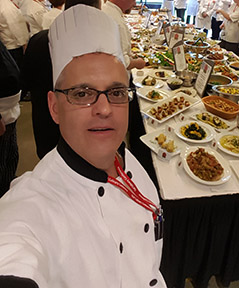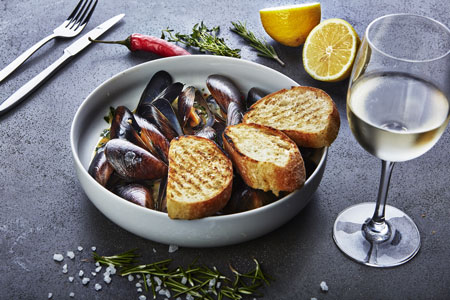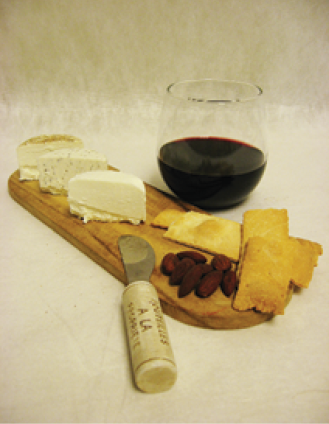Pairing Wine and Food: Tips from the Pros
There are many views on how to properly pair your wine and food for the most enjoyable dining experience. Three experts illustrate this while offering advice.

Chef: Mark Molinaro, Northern Arizona University at the W. A. Franke College of Business’ School of Hotel and Restaurant Management professor
The most basic principle in wine pairing is pairing like tastes — sour wines crave sour foods and rich wines crave rich foods. If you have a dish like trout meunière that has an acidic lemon and vinegar butter sauce then an acidic fresh Alsatian Trimbach Riesling would pair up properly. If you served a sweet German Spätlese, the sour in the sauce would be heightened due to the sweetness of the wine and seem out of place.
The more you learn about the wines you drink, the more information you’ll have in your wine rolodex. This makes choosing the best wine for the occasion much more enjoyable. So experiment and take notes — ultimately there are guidelines on what works and doesn’t but some of the fun is in the trying. I remember hearing 20 years ago that there were some foods that do not pair well with wine: Artichokes, asparagus, and Brussels sprouts come to mind. However, now I don’t buy into any of that. There are no hard and fast rules when it comes to pairing, only guidelines that you learn as part of the adventure. Taste, think, taste.
When it comes to my favorite pairings . . . I was recently cooking at a friend’s family home in Nice (I always wanted to say that) and we made a decadent braised osso buco with gremolata and served it over a creamy black pepper and pecorino risotto. Our host chose a 1985 Chateau Margaux that curled my toes! Another of my favorites is the classic plate of Stilton, dark chocolate, dried apricots, and toasted cashews served with a silky tawny Port — that’s the last taste I want before seeing the pearly gates.

Melissa Monosoff, Master Sommelier Diploma
My go-to theory is, “What grows together goes together.” In other words, pairing beverages and foods from the same country or region. Also, it is super important to learn how structural elements of wine such as sweetness, acidity, and tannins interact with food. Equally important is matching the intensity of the flavors in your wine with those of your food.
It totally depends on the scenario on whether to start with the wine or food when coming up with a pairing. If I have an awesome bottle of wine and need to figure out the food pairing or vice versa — a beautiful piece of fish I need to find the perfect wine for —either way works.
The perfect pairing, in my opinion, always involves Champagne or a sparkling wine, on every occasion. Champagne goes well with many styles of appetizers because the food often has salty elements that help mitigate the racy acidity of Champagne. Richer styles of Champagne can take you all the way through entrees with a great roasted chicken or even roast tenderloin. However, a mistake I see too often is wedding cake with dry Champagne. Remember, sweet Champagnes with dessert!
In the end, a perfect pairing may maximize enjoyment and elevate a dining experience, but I believe people should focus on drinking what they enjoy the most with whatever it is they are eating — perfect pairing or not. The worst thing you can do is overthink it to the point of non-enjoyment.

Chef: Kevin Cleary, Vin Bar & Shop, Burlington, Vermont
I know that the current thinking is “Drink what you want with whatever it is you’re eating,” and that’s fine. But, you can run into some major problems by following this rule. First and foremost would be to make sure that either the food or wine does not overpower the other. A huge, blockbuster Cabernet will obliterate a delicate dish of poached sole! Then, make sure the balance is there. If the food is intensely flavored, try to choose a wine that is equally intense in flavor and vice versa. Acidity is also a good example of this. If you have a high acid food, such as a tomato sauce or gastric, you are going to need a high acid wine. If the wine does not have enough acid it will taste dull and flabby because the acid in the food overwhelms the wine. People may balk at this reasoning and think that’s too much acidity but the food and wine will pair well as the acidity levels match.
The other basic principle I think everyone should pay attention to is the old adage of “white with fish and red with meat.” I know it’s not fashionable to follow this principle (see earlier) but it does make sense particularly when you’re drinking highly tannic wines.
Sweet foods are the hardest to pair, particularly chocolate. If the wine is not sweet the wine gets overwhelmed. Many people think that chocolate and red wine are classic combinations but more often than not this is a terrible combination. The chocolate coats the mouth (especially milk chocolate) with fats, tannins and sweet flavors. A tannic red will strip these away and all you are left with is the astringent tannins and acid from the wine. A better wine for chocolate would be Port (late bottled vintage or ruby), a sweet Lambrusco, or a sweet fortified.
For a dinner party with multiple courses that includes a fish and meat course I think Grenache or Grenache-based wines are a good choice. They’re usually fruity with softer tannins and nice bright acidity.






